
Published: Last Updated:
Readtime: 7 min
Every product is carefully selected by our editors and experts. If you buy from a link, we may earn a commission. Learn more. For more information on how we test products, click here.
I really like the idea of technology that can disappear when you don’t need it. It’s not an easy thing to accomplish, with every household now having an average of more than 20 devices, which each need their own proper place and space to work effectively. Add to that that, traditionally, the TV has been a big black box that we put pride of place in our living rooms, and it’s something that is typically difficult to hide.
Back in 2017, some enterprising minimalist at Samsung had the idea to combine that big black box with a literal work of art, launching the ‘Frame TV’, and suddenly every TV manufacturer is launching its own version. I’m not upset by any stretch – and I’d go so far as to say that Hisense’s Canvas TV is pretty close to perfect.
Coming in at AU$1,799, the Canvas TV delivers a 4K, matte display, capable of pushing up to a 240Hz refresh rate, all in the aesthetically pleasing frame of an artwork. It’s snappy, responsive, and when ‘switched off’ it displays a rotating collection of art from VIDAA (we’ll get to them in a bit) which, combined with the matte display, actually looks really good in your living room. Or, at least it did in mine.
There’s quite a bit to talk about with this panel – it tries to do a lot and succeeds at most of it – so let’s dive in.

Comparing the Competition
| Hisense Canvas TV 55S7NAU | Samsung The Frame 4K Smart TV (2024) | |
| Price | AU$1,799 | AU$1,799 |
| Display | – 55” ELED Display – 3840 x 2160 resolution – 144Hz refresh rate, 240Hz in smooth motion – 400nits brightness – HDR10/10+ – Anti-glare matte texture | – 55” QLED Display – 3840 x 2160 resolution – 100Hz refresh rate, 200Hz in smooth motion – ~400nits brightness – Quantum HDR/ HDR10+ – Anti-glare matte texture |
| OS | VIDAA U8 | Tizen Smart TV |
| Audio | 20W | 40W |
| Ports | – 2x HDMI 2.0 – 2x HDMI 2.1 – 1x USB-A 3.0 – 1x USB-A 2.0 – 1x Ethernet – 1x Audio Out – 1x Composite In | 4x HDMI 2.1 2x USB-A 1x Ethernet 1x Optical Out |
| Energy Efficiency | – AC100V-240V Power Supply – 4.5 Energy Rating – 0.5W power consumption in standby | – AC220-240V Power Supply – 3.5 Energy Rating – 0.5W power consumption in standby |
| Other | – VESA Wall Mount Compatible (300mm), included – Includes Remote – Includes Teak Frame Cover | – VESA Wall Mount Compatible (200mm), included – Includes Remote – Samsung One Connect Box Compatible |
Why Trust Us
Here at Man of Many, we use a wide variety of technology. We’re not fans of any one brand, like to get our hands on the latest-and-greatest tech before we call it the next-best-thing, and we’ve built up extensive experience in reviewing tech as a publication over the past 10 years.
The author of this article, Dean Blake, is Man of Many’s technology journalist, and has followed the industry for years. He was provided the product by Hisense for the purposes of this review. No money exchanged hands, and all opinions expressed are those of the author and haven’t been seen by Hisense ahead of time. For more information on our independence, testing, and review guidelines, you can read our full editorial policies here.
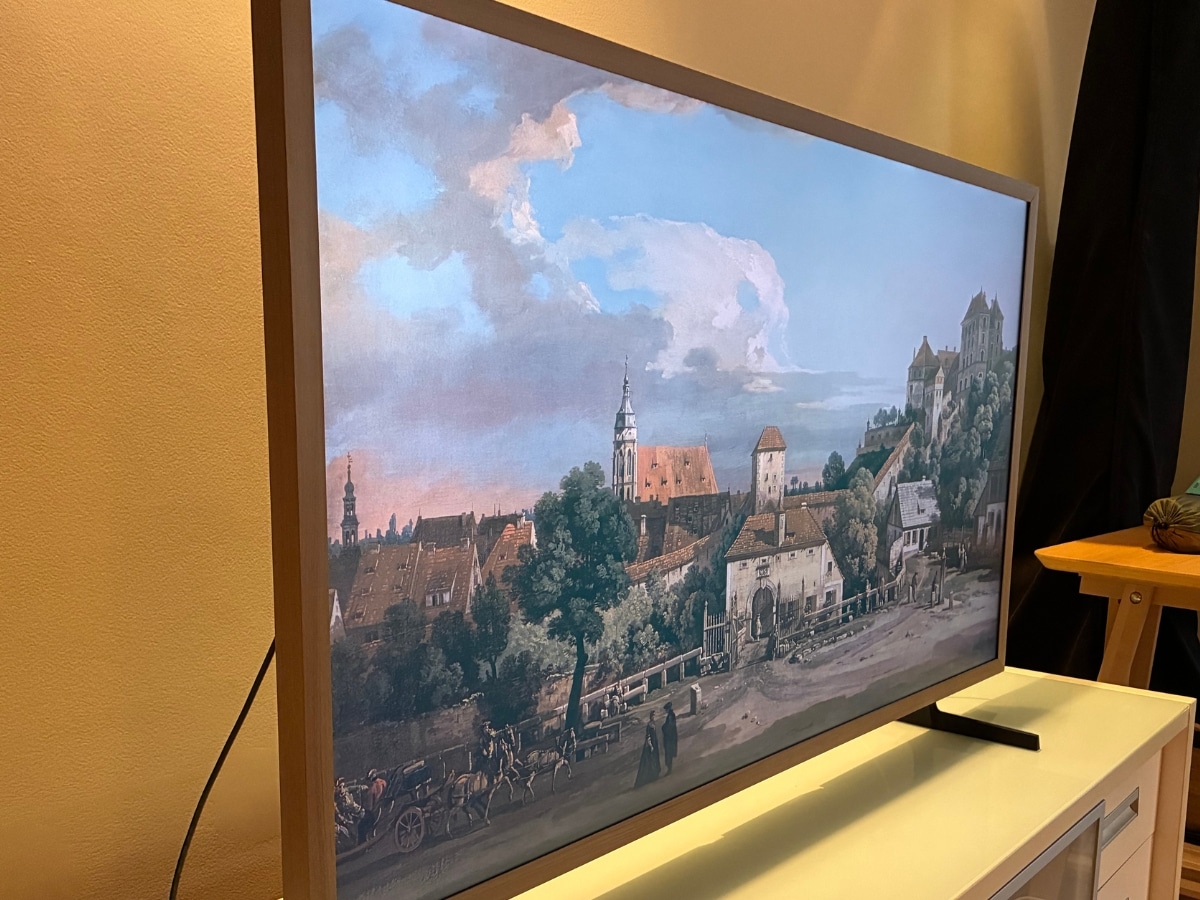
Art Mode
Let’s start with the main ‘feature’ of the Canvas TV: its ability to drop into a low-power state at the press of a button and effectively turn your TV into one of those digital photo-frames, but for art. With a long press of the included remote’s power button, you’ll still be able to turn the device off entirely, but simply pressing the button switches the display into ‘Art Mode’, which cycles through a number of impressively realistic-looking paintings.
Paired with the wooden trim (which was included in the box), the panel looks great – it’d look even better mounted to a wall, but, alas, I am a renter.
The TV will cycle through 300 art pieces out of the box, but if you need more, you can sign up for a free VIDAA account to get access to over 1,000 works. I didn’t feel the need, but if you’re planning on leaving the TV in art mode for the majority of the time while doing something else, it might be worth it for you.
It is a bit of a shame that there’s no way (as far as I could tell) to play music while also being in Art Mode to fulfil the true art-lounge fantasy.
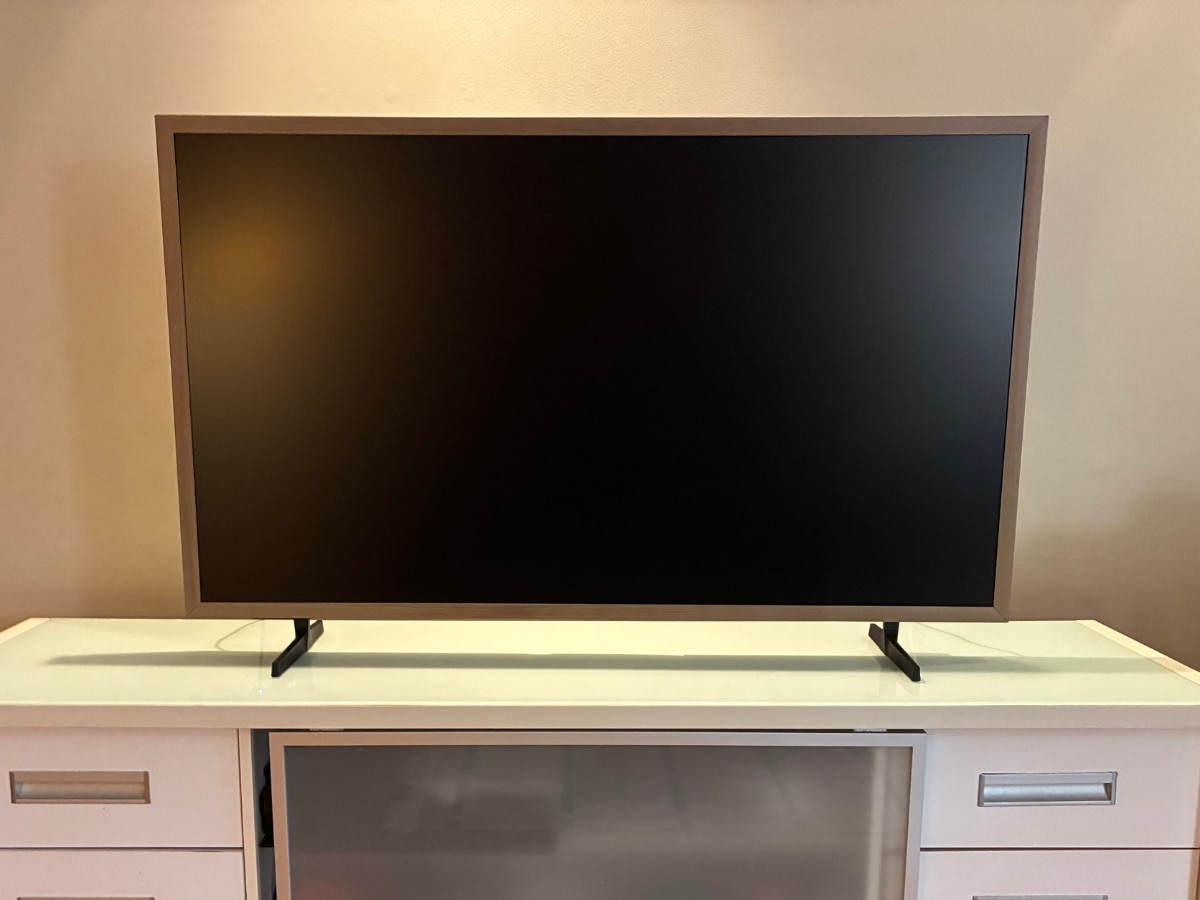
Easy on the Eye
One of the features I appreciate the most in Canvas TV is the fact that, unlike most other TV panels, it’s a flat, matte display. It’s easier on the eyes compared to a glossier screen, but it also means that not only does the display perform better during daylight hours – it also looks better in Art Mode.
Part of that ‘easy on the eyes’ feature is also the fact that, unlike so many other screens in our lives, the Cavas TV is an ELED display, or ‘Edge-Emitting Light Emitting Diode’. This is a less advanced form of LED than something like OLED, and uses lighting from the edge of the screen diffused over the entirety of the display to light up the image.
While this does lead to an overall ‘darker’ image than other TVs with higher brightness, in my mind it pairs well with the unit’s matte display.
Other ‘art’ TVs tend to give themselves away due to how shiny the screen is, but here you could genuinely mistake the display for an artwork thanks to the wooden-style bezel and matte surface, and I never had an issue making out what was on the screen, even in direct light, because of the non-reflective display.
VIDAA is actually the main OS the TV uses, and you’re going to get most of the same functionalities as Android TV but in a different format. This isn’t a review of the VIDAA OS, so I won’t spend too much time here, but it was very fast, very snappy, and intuitive. It had built-in access to all the streaming services I’d need, and switched between them almost immediately.
My partner and I watch a wide selection of shows, from the high-speed antics of Drive to Survive, to the weird and wonderful world of Severance, to documentaries from decades ago, and all of it looked fantastic on the Canvas TV. The high refresh rate kept the speed of Formula 1 intact, while the high resolution made every detail pop.
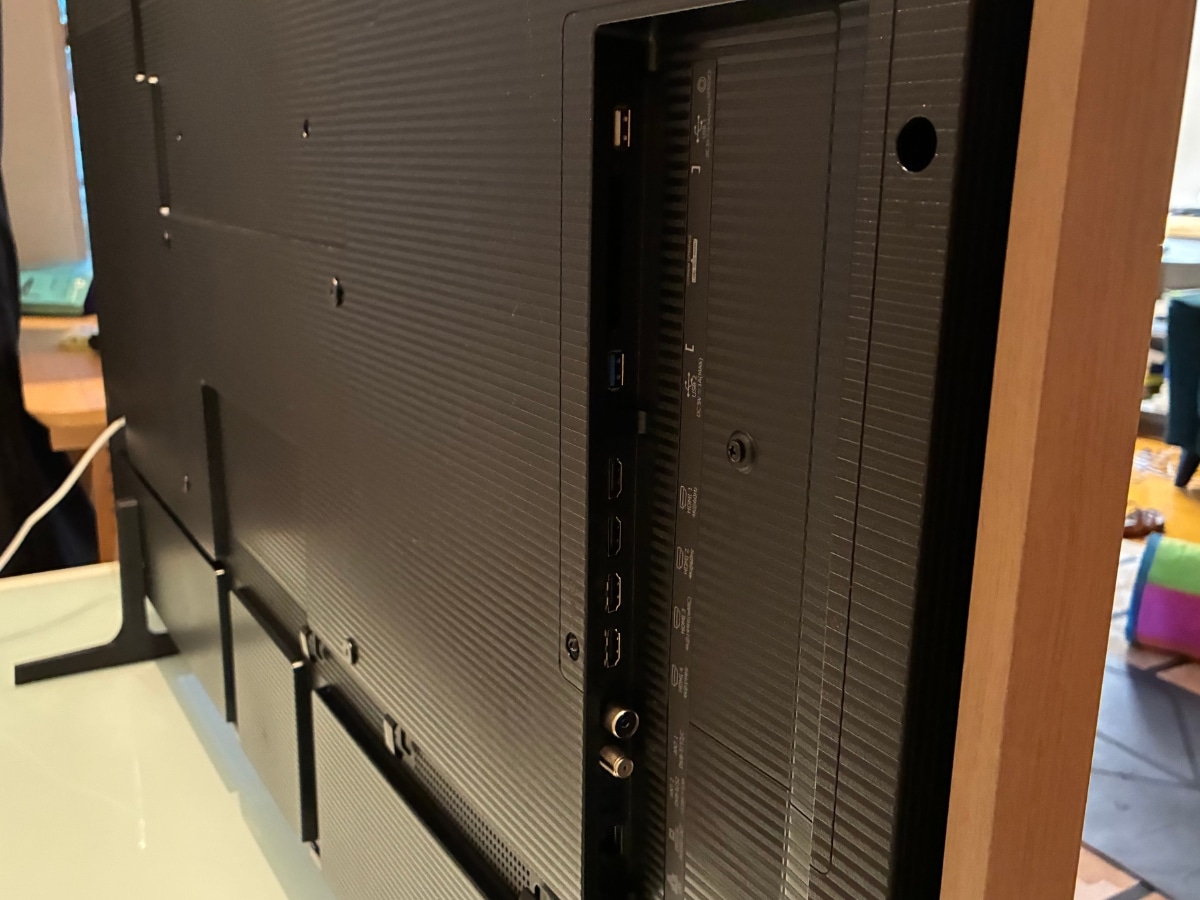
Port Selection is Decent
Four HDMI ports and two USB-A ports are pretty standard in TVs these days, and it’s good that the Canvas TV clears this bar. I wouldn’t go so far as to say it offers something amazing in the way of connectivity, but it has the basics covered.
One little feature that I appreciate is that while the power input and HDMI ports are on different ends of the unit, Hisense built a channel into the backside of the TV to feed the power cable through in case you want to hide or consolidate your cables together.
This effectively allows all cables to exit on the same side of the TV and helps you keep it all neat and tidy, and if you’re looking at a TV that aims to double as an artwork, that’s a feature you’re probably going to want.
Do We Recommend the Hisense Canvas TV?
The Canvas TV is a fantastic display, and the combination of high resolution with an anti-glare matte display made everything we watched look fantastic. If you’re looking for an aesthetically pleasing upgrade to your current kit, Hisense’s Canvas TV is definitely one to consider.









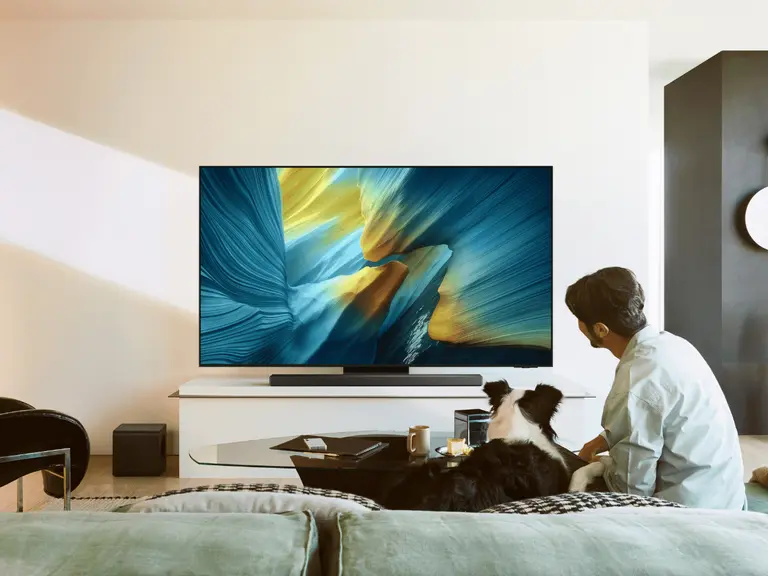


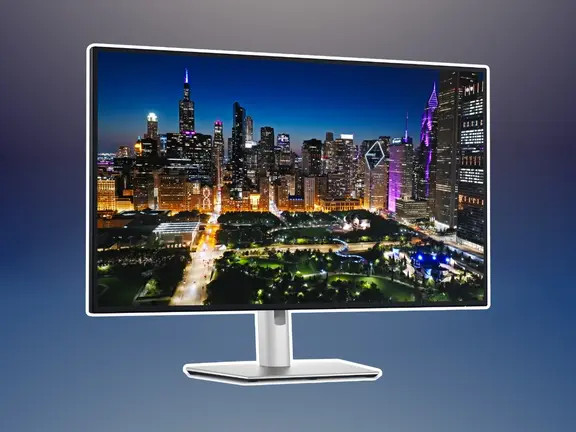














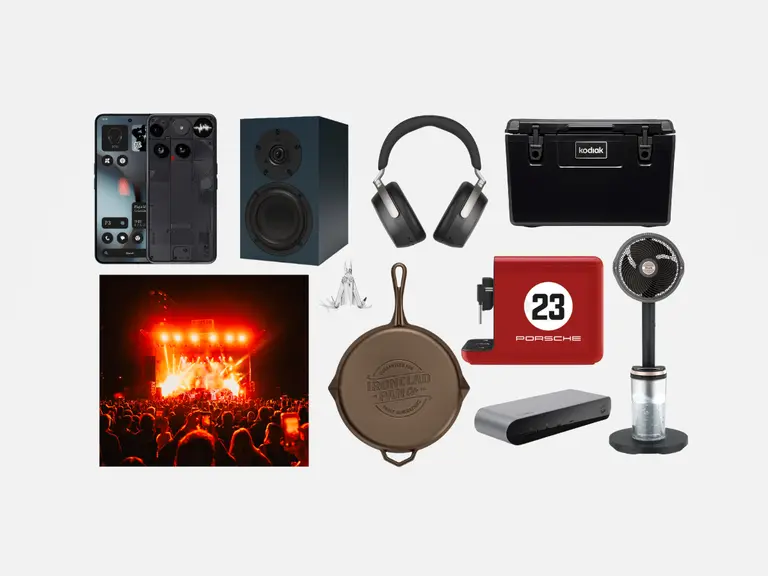






Comments
We love hearing from you. or to leave a comment.